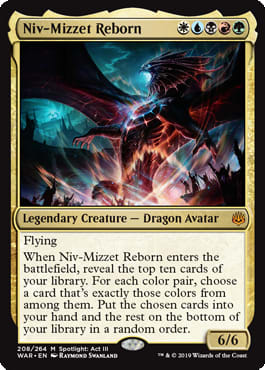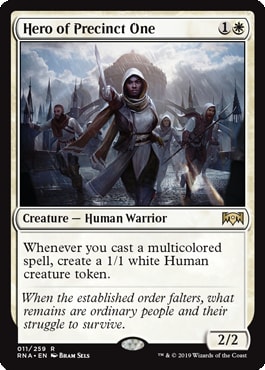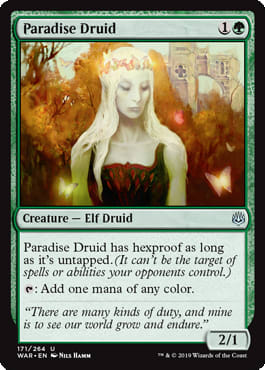Welp, that does it. I've finally found my favorite War of the Spark card. We can shut down the previews. Don't really need to see anything else.
If the title hadn't completely given it away, I'm talking about Niv-Mizzet Reborn: the five-color, five-mana legendary dragon that has the potential to draw you ten cards when he enters the battlefield!
Welcome back, everyone! Today, I want to talk about the Dracogenius himself. One of my favorite cards of all time is Mulldrifter. For 5 mana you get a 2/2 flier that draws you two cards when it enters the battlefield. I think there's a lot to compare here with Mulldrifter, so let's jot down an initial pros and cons list!
Pros for Niv
- Niv is a 6/6 instead of a 2/2.
- Niv is a sicko dragon.
- Niv has the potential to draw you up to ten cards, but will on average draw you three-four cards.
Cons against Niv
- Mulldrifter is easier to cast.
- Mulldrifter can be evoked.
I think that's about it, really, but truth be told, I don't think you're ever really happy when you have to evoke a Mulldrifter. Additionally, in a format with shock lands and check lands, I really don't think Niv-Mizzet Reborn is going to be that difficult to cast on turn five. Or on turn four if you manage to land a Chromatic Lantern on turn three, which seems nuts.
Other than Mulldrifter, the closest card I keep thinking to compare Niv to is Dig Through Time, a card that has been banned or restricted in nearly every format it has been legal. While you can't cheat on mana with Niv the same way you can with Dig, you are able to look at three more cards and, depending on how well you built your deck, are likely to draw more than two of them.
What I want to do today is take a look at what a preliminary Niv-Mizzet Reborn deck list might look like for War of the Spark Standard. I don't think is going to be an easy exercise, especially considering the amount of slots we're going to want to devote to two-color cards, color fixing, and lands. I do think, based on both Niv's ability and the diversity of two-color cards we want to include, that the deck would like to only have an average of two copies of each two-color card, with very few, if any, being four-ofs.
The first thing I did for this exercise was go through all of the legal two-color cards in all of Standard that I felt were competitively playable. There are . . . quite a few of them. (And believe me, I wish Nicol Bolas, Dragon-God was only two colors.)
Azorius
Dimir
Rakdos
Gruul
Selesnya
Orzhov
Izzet
Golgari
Boros
Simic
Based on all of these, you might notice that there are very few six-drops, meaning that despite feeling like somewhat of a control deck, our curve is very likely to stop at five. This is nice because it means that even though we have a complicated mana base, we don't necessarily need a million lands for our deck to function successfully.
One card I felt that was absurdly appropriate for our deck was Hero of Precinct One. Considering this should trigger off of nearly 50% of our deck, I felt like it was a strong card to help churn out some defensive (or offensive) creatures while we assemble our mana base.
While we mentioned Chromatic Lantern several times, and we're clearly including four of them, if we wanted to add another creature to ramp and fix our mana, Paradise Druid could be a good choice. Not only will it always survive to use it at least once, it can also add mana of any color (unlike the popular Incubation Druid), which is huge. Alternatively, this could be a Growth Spiral slot, which also ends up being a card we can draw off of Niv. I think either of these are fine. With the Druid you will always get at least one extra mana, while the Spiral has more synergy.
Treasure Map is of course another options, but it takes a little bit of effort to get going. Additionally, if our deck has four Hero of Precinct One, four Chromatic Lantern, and four Paradise Druid, counting our (presumably) 25 lands, that leaves us with only 23 slots to add two-color cards, which I think should fill all of them.
Looking over what we have available, I think a good preliminary list could look something like this:
Niv-Mizzet Midrange | War Standard | Frank Lepore
- Creatures (17)
- 1 Ravager Wurm
- 2 Hostage Taker
- 2 Knight of Autumn
- 2 Seraph of the Scales
- 2 Thief of Sanity
- 4 Hero of Precinct One
- 4 Niv-Mizzet Reborn
- Planeswalkers (3)
- 1 Vraska, Relic Seeker
- 2 Teferi, Hero of Dominaria
- Spells (15)
- 1 Bedevil
- 1 Dovin's Veto
- 1 Justice Strike
- 1 Mortify
- 2 Assassin's Trophy
- 3 Growth Spiral
- 1 Enter the God-Eternals
- 1 Find // Finality
- 4 Chromatic Lantern
- Lands (25)
- 1 Blood Crypt
- 1 Dragonskull Summit
- 1 Drowned Catacomb
- 1 Isolated Chapel
- 1 Rootbound Crag
- 1 Sacred Foundry
- 1 Steam Vents
- 1 Stomping Ground
- 1 Sulfur Falls
- 1 Sunpetal Grove
- 1 Woodland Cemetery
- 2 Breeding Pool
- 2 Glacial Fortress
- 2 Godless Shrine
- 2 Hallowed Fountain
- 2 Overgrown Tomb
- 2 Temple Garden
- 2 Watery Grave
This leaves us with the following distribution of two-color pairs:
Azorius: 3
Boros: 1
Dimir: 5
Golgari: 4
Gruul: 1
Izzet: 0
Orzhov: 3
Rakdos: 1
Selesnya: 2
Simic: 3
While it's impossible to draw all ten cards without any Izzet present, this feels like a good enough distribution of all the other pairs as to allow us to draw at least three or four cards. (I'm looking forward to finding out once the set is available on MTG Arena and Magic Online!) One thing I could see doing, based on how vital hitting our land drops is, especially with Growth Spiral, is cutting one of the Teferi (because Niv should draw us all the cards we need, realistically) and adding a 26th land. I also made an attempt to not play any cards with two of the same color in the casting cost other than the single Ravager Wurm (because I just love that card) and the single Bedevil (such versatility). Those both also fulfill the Rakdos and Gruul slots nicely.
For the mana base, I primitively just added up the symbols (removing four of each for Niv, which was a wash) and made sure that we had the most ways to cast the colors that were represented the most, which broke down as follows:
![]() : 13
: 13
![]() : 12
: 12
![]() : 14
: 14
![]() : 3
: 3
![]() : 11
: 11
Because of this, our main deck has 11 sources of White, 11 sources of Blue, 11 sources of Black, 7 sources of Red, and 10 sources of Green. The mana base might be the messiest part of the deck, as it's just preliminary and impossible to test currently, but I expect it to improve once we can get some reps in with the deck. Even though Red is the least represented color in the with only three Red cards, we still need to make sure we have Red mana to cast the deck's namesake card. Having 11 sources in total with Chromatic Lantern should definitely help in this area, but if worse comes to worse, I could see simply replacing the Growth Spirals with the Paradise Druids as we discussed earlier. All that being said, I would kill for a Mana Confluence or a Reflecting Pool in this format.
The tricky thing about this deck is that is strikes me as something there isn't a perfect way to build - there are simply too many options and configurations - but if Niv-Mizzet Reborn does become a contender in the metagame, you can almost guarantee that the hive mind will come up with an agreed upon "best" list, with players swapping cards of their choosing in and out as each week's metagame dictates.
War of the Spark has me extremely jazzed to play Standard right now, which is something I haven't felt for a while. It feels like there are too many interesting and unique cards (and planeswalkers) in the format for it to quickly be figured out, and that's appealing to me. Ideally you may see me at an upcoming Standard event with Niv-Mizzet sleeved up and ready to battle, but only time will tell.
As usual, thanks a ton for reading and I'm really looking forward to your thoughts on both the list and Niv-Mizzet in general, so definitely drop in for a comment! You can also make sure to pop on over to my Twitch channel and catch me at least five days a week. Love you guys and I'll see you next week!
Frank Lepore




























